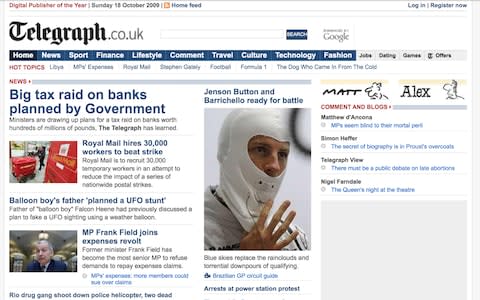Happy birthday to us! Why we've turned off our paywall for 25 hours

A birthday greeting from Barney Henderson, online editor, Telegraph.co.uk
Dear Reader,
Twenty five years ago this week, on November 15 1994, the Telegraph website launched in the corner of a backroom at our old headquarters in London's Canary Wharf. We were the first newspaper in the country - and indeed Europe - to launch a website.
It was a watershed moment in the history of British newspapers, ushering in a new digital era. We are equally proud of our digital history and innovation as we are of the quality of our website today and our exciting plans for the future.
To celebrate our landmark 25th birthday, we're opening up thousands of articles usually only accessible to subscribers for 25 hours*. This will allow you to enjoy our best content for free.
There's no better time to keep yourself informed and entertained via all the superb sections of the website: from sport to culture, business to life & style, tech to travel and much more. With the general election just weeks away, our political coverage and comment regularly sets the nation's daily news agenda and makes sense of the current turmoil, while our excellent daily live blog is often first when the big news breaks.
Back in 1994, the world was a very different place. Nelson Mandela was sworn in as president of South Africa, the Channel tunnel was opened and Maastricht Treaty recently implemented, the first episode of Friends aired on US TV, Kurt Cobain committed suicide, Michael Schumacher won his first Formula One world title and Boris Johnson was appointed Assistant Editor of The Daily Telegraph.
The internet, which had only been invented four years before, was niche. Some saw it as a little geeky, while many others were not even aware it existed. Just one per cent of the country had the internet in their homes, which was accessed via a painfully slow, unreliable and noisy dial-up system. Today, partly thanks to our better broadband campaign more than 90 per cent of homes in the UK have access.
It's hard to imagine that anyone, even the early pioneers of the World Wide Web, could have predicted in those early days how revolutionary it would become.
The Telegraph, however, was way out in front.
The website, known then as the Electronic Telegraph, splashed on day one on a story about an inquiry into MPs' finances, with the headline: 'Tories block open inquiry on MPs' cash.'

Fifteen years later, of course, the Telegraph would deliver the Fleet Street scoop of the century so far, the MPs' expenses scandal.
With small thumbnail pictures and a grey background, the website had just one daily edition - and there was impassioned debate about whether journalism should be free to access online.
The evolution of the site's design and functionality - and general attitudes towards digital journalism - were rapid. It wasn't long before the website was reacting to breaking news, producing digital-only content alongside our excellent print articles and experimenting with the use of video. We also started making intelligent use of the Telegraph's peerless archive and historical resources.
It was quickly realised that we could expand our global reach via the website. Dispatches from Washington DC from our correspondent Ambrose Evans-Pritchard on Bill Clinton and the Whitewater controversy in the mid-1990s brought a large - and new - American audience to the Telegraph and forced the White House to publish a 331-page report accusing Ambrose of peddling "Right-wing inventions". Ambrose continues to ask the difficult questions today, with his unique brand of investigative journalism and superb analysis pieces for the Telegraph.
While our website has gone through several major redesigns and relaunches - not least in August this year - we have never stood still.
We continue to take huge strides with our digital strategy, audience growth and the quality of our journalism across all our platforms. Our subscription model is helping both to sustain and expand our vital journalism and build a commercially viable future for the industry.

Our newsroom is fully integrated, so there is reassuring continuity and quality across the website and the newspapers.
On new platforms we are continually expanding our reach and driving engagement with you, the reader:
- Our communities team encourages meaningful debate around the subjects that matter to you, tripling the number of comments posted by readers and responding to your feedback and concerns.
- Our dozens of newsletters, such as City Intelligence, Parenting, Rugby Nerd, Your Royal Appointment and our morning and afternoon Front Page news briefings are subscribed to by hundreds of thousands of you.
- On Snapchat, more than a million people a day view our edition, three quarters of whom are under 25, with a modern storytelling approach that stays true to our brand values.
- We were the first UK publishers to fully explore how WhatsApp can help us to interact with our readership, with tens of thousands signing up for politics, rugby, football and royal fashion groups.
- High quality journalism on Instagram and other social channels has seen our engaged audience grow rapidly.
Our Women Mean Business campaign, which runs across digital, print and live events has led to positive change to get a better deal for women - we are pushing to close the funding gap for female entrepreneurs in Britain.
Duty of Care, launched in 2018, called for tighter regulations for social media, making several breakthroughs in the battle for a safer internet.
While our groundbreaking Telegraph Women's Sport initiative delivers unprecedented investment in and coverage of women's sport by a UK publisher.
We really are proud of everything we've achieved in the past 25 years and we hope you are as excited as we are about our next quarter century.
What the internet - and the journalism industry - will look like 25 years from today really is anyone's guess, but the Telegraph will be by your side - possibly on screen, in print or maybe via some as yet unknown medium - to inform, question, inspire and entertain.
Barney Henderson Editor, Telegraph.co.uk
* There are a small number of exceptions which remain subscriber-only for this period.

 Yahoo News
Yahoo News 
